Balbharti Maharashtra State Board 11th Physics Textbook Solutions
Chapter 3 Motion in a Plane Textbook Exercise Questions and Answers.
1. Choose the correct option.
Question 1.
An object thrown from a moving bus is on example of __________
(A) Uniform circular motion
(B) Rectilinear motion
(C) Projectile motion
(D) Motion in one dimension
Answer:
(C) Projectile motion
Question 2.
For a particle having a uniform circular motion, which of the following is constant ____________.
(A) Speed
(B) Acceleration
(C) Velocity
(D) Displacement
Answer:
(A) Speed

Question 3.
The bob of a conical pendulum undergoes ___________
(A) Rectilinear motion in horizontal plane
(B) Uniform motion in a horizontal circle
(C) Uniform motion in a vertical circle
(D) Rectilinear motion in vertical circle
Answer:
(B) Uniform motion in a horizontal circle
Question 4.
For uniform acceleration in rectilinear motion which of the following is not correct?
(A) Velocity-time graph is linear
(B) Acceleration is the slope of velocity time graph
(C) The area under the velocity-time graph equals displacement
(D) Velocity-time graph is nonlinear
Answer:
(D) Velocity-time graph is nonlinear
Question 5.
If three particles A, B and C are having velocities \(\overrightarrow{\mathrm{v}}_{A}\), \(\overrightarrow{\mathrm{v}}_{B}\) and \(\overrightarrow{\mathrm{v}}_{C}\) which of the following formula gives the relative velocity of A with respect to B
(A) \(\overrightarrow{\mathrm{v}}_{A}\) + \(\overrightarrow{\mathrm{v}}_{B}\)
(B) \(\overrightarrow{\mathrm{v}}_{A}\) – \(\overrightarrow{\mathrm{v}}_{C}\) + \(\overrightarrow{\mathrm{v}}_{B}\)
(C) \(\overrightarrow{\mathrm{v}}_{A}\) – \(\overrightarrow{\mathrm{v}}_{B}\)
(D) \(\overrightarrow{\mathrm{v}}_{C}\) – \(\overrightarrow{\mathrm{v}}_{A}\)
Answer:
(C) \(\overrightarrow{\mathrm{v}}_{A}\) – \(\overrightarrow{\mathrm{v}}_{B}\)
2. Answer the following questions.
Question 1.
Separate the following in groups of scalar and vectors: velocity, speed, displacement, work done, force, power, energy, acceleration, electric charge, angular velocity.
Answer:
Scalars
Speed, work done, power, energy, electric charge.
Vectors
Velocity, displacement, force, acceleration, angular velocity (pseudo vector).

Question 2.
Define average velocity and instantaneous velocity. When are they same?
Answer:
Average velocity:
Instantaneous velocity:
In case of uniform rectilinear motion, i.e., when an object is moving with constant velocity along a straight line, the average and instantaneous velocity remain same.
Question 3.
Define free fall.
Answer:
The motion of any object under the influence of gravity alone is called as free fall.
Question 4.
If the motion of an object is described by x = f(t) write formulae for instantaneous velocity and acceleration.
Answer:
Question 5.
Derive equations of motion for a particle moving in a plane and show that the motion can be resolved in two independent motions in mutually perpendicular directions.
Answer:

Question 6.
Derive equations of motion graphically for a particle having uniform acceleration, moving along a straight line.
Answer:
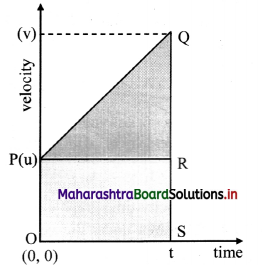
Question 7.
Derive the formula for the range and maximum height achieved by a projectile thrown from the origin with initial velocity \(\vec{u}\) at an angel θ to the horizontal.
Answer:
Expression for range:
Expression for maximum height of a projectile:
The maximum height H reached by the projectile is the distance travelled along the vertical (y) direction in time tA.
Substituting sy = H and t = ta in equation (1),
we have,
H = (u sin θ)tA – \(\frac{1}{2}\) gtA2

This equation represents maximum height of projectile.
Question 8.
Show that the path of a projectile is a parabola.
Answer:

Question 9.
What is a conical pendulum? Show that its time period is given by 2π \(\sqrt{\frac{l \cos \theta}{g}}\), where l is the length of the string, θ is the angle that the string makes with the vertical and g is the acceleration due to gravity.
Answer:
A simple pendulum, Ch i given such a motion that the bob describes a horizontal circle and the string making a constant angle with the vertical describes a cone, is called a conical pendulum.
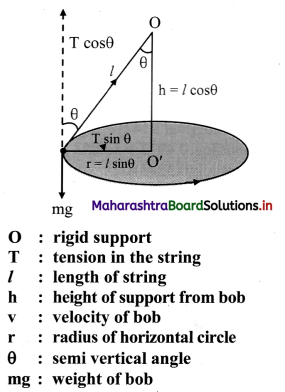

Question 10.
Define angular velocity. Show that the centripetal force on a particle undergoing uniform circular motion is -mω2\(\vec{r}\).
Answer:
Angular velocity of a particle is the rate of change of angular displacement.
Expression for centripetal force on a particle undergoing uniform circular motion:
i) Suppose a particle is performing U.C.M in anticlockwise direction.
The co-ordinate axes are chosen as shown in the figure.
Let,
A = initial position of the particle which lies on positive X-axis
P = instantaneous position after time t
θ = angle made by radius vector
ω = constant angular speed
\(\overrightarrow{\mathrm{r}}\) = instantaneous position vector at time t
ii) From the figure,
\(\overrightarrow{\mathrm{r}}=\hat{\mathrm{i}} \mathrm{x}+\hat{\mathrm{j}} \mathrm{y}\)
where, \(\hat{\mathrm{i}}\) and \(\hat{\mathrm{j}}\) are unit vectors along X-axis and Y-axis respectively.
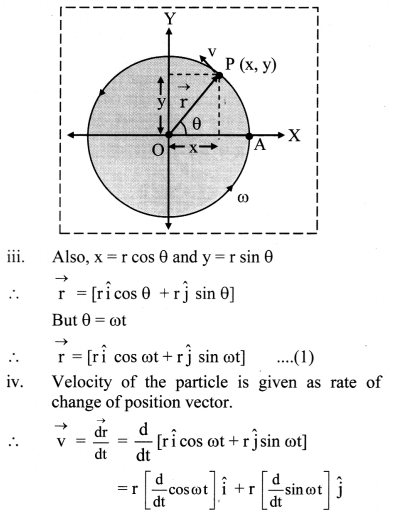
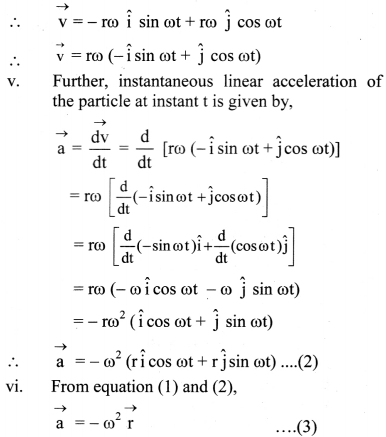
Negative sign shows that direction of acceleration is opposite to the direction of position vector. Equation (3) is the centripetal acceleration.
vii) Magnitude of centripetal acceleration is given by a = ω2r
viii) The force providing this acceleration should also be along the same direction, hence centripetal.
∴ \(\overrightarrow{\mathrm{F}}\) = m\(\overrightarrow{\mathrm{a}}\) = -mω2\(\overrightarrow{\mathrm{r}}\)
This is the expression for the centripetal force on a particle undergoing uniform circular motion.
ix) Magnitude of F = mω2r = \(\frac{\mathrm{mv}^{2}}{\mathrm{r}}\) = mωv
[Note: The definition of angular velocity is not mentioned in this chapter but is in Ch.2 Mathematical Methods.]
3. Solve the following problems.
Question 1.
An aeroplane has a run of 500 m to take off from the runway. It starts from rest and moves with constant acceleration to cover the runway in 30 sec. What is the velocity of the aeroplane at the take off ?
Answer:
Given: Length of runway (s) = 500 m, t = 30 s
To find: Velocity (y)
Formulae. i) s = ut + \(\frac{1}{2}\) at2
ii) v = u + at
Calculation: As the plane was initially at rest, u = 0
From formula (1),
500 = 0 + \(\frac{1}{2}\) × a × (30)2
∴ 500 = 450 a
∴ a = \(\frac{10}{9}\) m/s2
From formula (ii),
v = 0 + \(\frac{10}{9}\) × 30
∴ v = \(\frac{100}{3}\) m/s = (\(\frac{100}{3} \times \frac{18}{5}\)) km/hr
∴ v = 120 km/hr
The velocity of the aeroplane at the take off is 120 km/hr.

Question 2.
A car moving along a straight road with a speed of 120 km/hr, is brought to rest by applying brakes. The car covers a distance of 100 m before it stops. Calculate
(i) the average retardation of the car
(ii) time taken by the car to come to rest.
Answer:
Given: u = 120 kmh-1 = 120 × \(\frac{5}{18}\) = \(\frac{100}{3}\) ms-1
s = 100 m, v = 0
To find: i) Average retardation of the car (a)
ii) Time taken by car (t)
Formulae: i) v2 – u2 = 2as
ii) v = u + at
Calculation: From formula (i),
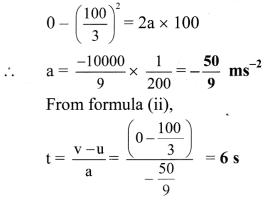
i) Average retardation of the car is \(\frac{50}{9}\) ms2 (in magnitude).
ii) Time taken by the car to come to rest is 6 s.
Question 3.
A car travels at a speed of 50 km/hr for 30 minutes, at 30 km/hr for next 15 minutes and then 70 km/hr for next 45 minutes. What is the average speed of the car?
Answer:
Given: v1 = 50 km/hr. t1 = 30 minutes = 0.5 hr,
v2 = 30 km/hr, t2 = 15 minutes = 0.25 hr,
v3 = 70 km/hr, t3 = 45 minutes 0.75 hr
To find: Average speed of car (vav)
Formula vav = \(\frac{\text { total path length }}{\text { total time interval }}\)
Calculation:
Path length,
x1 = v1 × t1 = 50 × 0.5 = 25km
x2 = v2 × t2 = 30 × 0.25 = 7.5 km
x3 = v3 × t3 = 70 × 0.75 = 52.5 km
From formula,
vav = \(\frac{x_{1}+x_{2}+x_{3}}{t_{1}+t_{2}+t_{3}}\)
∴ vav = \(\frac{25+7.5+52.5}{0.5+0.25+0.75}=\frac{85}{1.5}\)
∴ vav = 56.66 km/hr
Question 4.
A velocity-time graph is shown in the adjoining figure.
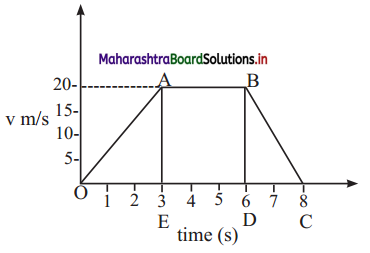
Determine:
Answer:
Question 5.
A man throws a ball to maximum horizontal distance of 80 meters. Calculate the maximum height reached.
Answer:
Given: R = 80m
To find: Maximum height reached (Hmax)
Formula: Rmax = 4Hmax
Calculation: From formula,
∴ Hmax = \(\frac{\mathrm{R}_{\max }}{4}=\frac{80}{4}\) = 20 m
The maximum height reached by the ball is 20m.

Question 6.
A particle is projected with speed v0 at angle θ to the horizontal on an inclined surface making an angle Φ (Φ < θ) to the horizontal. Find the range of the projectile along the inclined surface.
Answer:
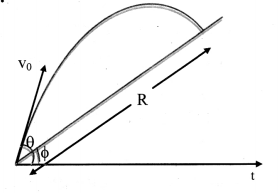
i) The equation of trajectory of projectile is given by,
y(tan θ)x – (\(\frac{\mathrm{g}}{2 \mathrm{u}^{2} \cos ^{2} \theta}\))x2 …………..(1)
ii) In this case to find R substitute,
y = R sinΦ ………….. (2)
x = R cosΦ ………….. (3)
iii) From equations (1), (2) and (3),
we have,
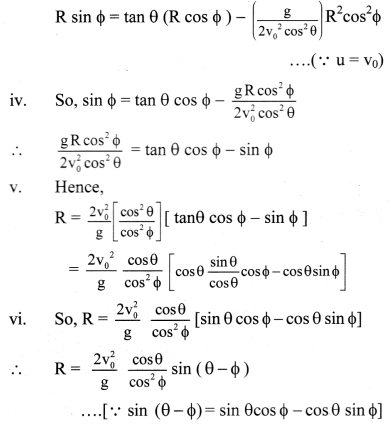
Question 7.
A metro train runs from station A to B to C. It takes 4 minutes in travelling from station A to station B. The train halts at station B for 20 s. Then it starts from station B and reaches station C in next 3 minutes. At the start, the train accelerates for 10 sec to reach the constant speed of 72 km/hr. The train moving at the constant speed is brought to rest in 10 sec. at next station.
(i) Plot the velocity- time graph for the train travelling from the station A to B to C.
(ii) Calculate the distance between the stations A, B and C.
Answer:
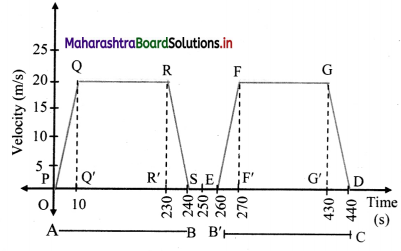
The metro train travels from station A to station B in 4 minutes = 240 s.
The trains halts at station B for 20 s.
The train travels from station B’ to station C in 3 minutes= 180 s.
∴ Total time taken by the metro train in travelling from station A to B to C
= 240 + 20 + 180 = 440 s.
At start, the train accelerates for 10 seconds to reach a constant speed of 72 km/hr = 20 m/s.
The train moving is brought to rest in 10 s at next station.
The velocity-time graph for the train travelling from station A to B to C is as follows:
Distance travelled by the train from station A to station B
= Area of PQRS
= A ( △PQQ’) A (☐QRR’) + A(SRR’)
= (\(\frac{1}{2}\) × 10 × 20 + (220 × 20) + (\(\frac{1}{2}\) 10 × 20)
= 100 + 4400 + 100
= 4600m = 4.6km
Distance travelled by the train from station B’ to station C
= Area of EFGD
= A(△EFF’) + A(☐F’FGG’) + A(△DGG’)
= (\(\frac{1}{2}\) × 10 × 20) × (160 × 20) + (\(\frac{1}{2}\) × 10 × 20)
= 100 + 3200 + 100
= 3400m = 3.4km
Question 8.
A train is moving eastward at 10 m/sec. A waiter is walking eastward at 1.2m/sec; and a fly is flying toward the north across the waiter’s tray at 2 m/s. What is the velocity of the fly relative to Earth.
Answer:
Given
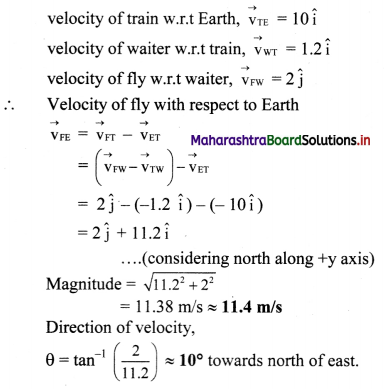
Question 9.
A car moves in a circle at the constant speed of 50 m/s and completes one revolution in 40 s. Determine the magnitude of acceleration of the car.
Answer:
Given: v = 50 m/s, t = 40 s, s = 2πr
To find: acceleration (a)
Formulae: i) v = \(\frac{\mathrm{s}}{\mathrm{t}}\)
ii) a = \(\frac{\mathrm{v}^{2}}{\mathrm{r}}\)
Calculation: From formula (i),
50 = \(\frac{2 \pi \mathrm{r}}{40}\)
∴ r = \(\frac{50 \times 40}{2 \pi}\)
∴ r = \(\frac{1000}{\pi}\) cm
From formula (ii),
a = \(\frac{v^{2}}{r}=\frac{50^{2}}{1000 / \pi}\)
∴ a = \(\frac{5 \pi}{2}\) = 7.85 m/s2
The magnitude of acceleration of the car is 7.85 m/s.
Alternate method:
Given: v = 50 m/s, t = 40 s,
To find: acceleration (a)
Formula: a = rω2 = vω
Calculation: From formula,
a = vω
= v(\(\frac{2 \pi}{\mathrm{t}}\))
= 50(\(\frac{2 \times 3.142}{40}\))
= \(\frac{5}{2}\) × 3.142
∴ a = 7.85m/s2

Question 10.
A particle moves in a circle with constant speed of 15 m/s. The radius of the circle is 2 m. Determine the centripetal acceleration of the particle.
Answer:
Given: v = 15 m/s, r = 2m
To find: Centripetal acceleration (a)
Formula: a = \(\frac{\mathrm{v}^{2}}{\mathrm{r}}\)
Calculation: From formula,
a = \(\frac{(15)^{2}}{2}=\frac{225}{2}\)
∴ a = 112.5m/s2
The centripetal acceleration of the particle is 112.5 m/s2.
Question 11.
A projectile is thrown at an angle of 30° to the horizontal. What should be the range of initial velocity (u) so that its range will be between 40m and 50 m? Assume g = 10 m s-2.
Answer:
Given: 40 ≤ R ≤ 50, θ = 300, g = 10 m/s2
To find: Range of initial velocity (u)
Formula: R = \(\frac{\mathrm{u}^{2} \sin (2 \theta)}{\mathrm{g}}\)
Calculation: From formula,
The range of initial velocity,
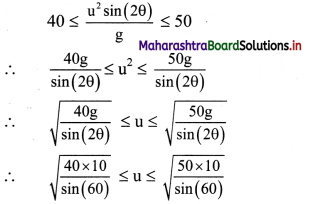
∴ 21.49m/s ≤ u ≤ 24.03m/s
The range of initial velocity should be between 21.49 m/s ≤ u ≤ 24.03 m/s.
11th Physics Digest Chapter 3 Motion in a Plane Intext Questions and Answers
Can you recall? (Textbook Page No. 30)
Question 1.
What ¡s meant by motion?
Answer:
The change ¡n the position of an object with respect to its surroundings is called motion.
Question 2.
What Is rectilinear motion?
Answer:
Motion in which an object travels along a straight line is called rectilinear motion.
Question 3.
What is the difference between displacement and distance travelled?
Answer:
Question 4.
What is the difference between uniform and non-uniform motion?
Answer:
Internet my friend (Textbook Page No. 44)
i. hyperphysics.phy-astr.gsu.eduJhbase/mot.html#motcon
ii. www .college-physics.comlbook/mechanics
[Students are expected to visit the above mentioned webs ires and collect more information.]
Chapter 3 Motion in a Plane Textbook Exercise Questions and Answers.
1. Choose the correct option.
Question 1.
An object thrown from a moving bus is on example of __________
(A) Uniform circular motion
(B) Rectilinear motion
(C) Projectile motion
(D) Motion in one dimension
Answer:
(C) Projectile motion
Question 2.
For a particle having a uniform circular motion, which of the following is constant ____________.
(A) Speed
(B) Acceleration
(C) Velocity
(D) Displacement
Answer:
(A) Speed

Question 3.
The bob of a conical pendulum undergoes ___________
(A) Rectilinear motion in horizontal plane
(B) Uniform motion in a horizontal circle
(C) Uniform motion in a vertical circle
(D) Rectilinear motion in vertical circle
Answer:
(B) Uniform motion in a horizontal circle
Question 4.
For uniform acceleration in rectilinear motion which of the following is not correct?
(A) Velocity-time graph is linear
(B) Acceleration is the slope of velocity time graph
(C) The area under the velocity-time graph equals displacement
(D) Velocity-time graph is nonlinear
Answer:
(D) Velocity-time graph is nonlinear
Question 5.
If three particles A, B and C are having velocities \(\overrightarrow{\mathrm{v}}_{A}\), \(\overrightarrow{\mathrm{v}}_{B}\) and \(\overrightarrow{\mathrm{v}}_{C}\) which of the following formula gives the relative velocity of A with respect to B
(A) \(\overrightarrow{\mathrm{v}}_{A}\) + \(\overrightarrow{\mathrm{v}}_{B}\)
(B) \(\overrightarrow{\mathrm{v}}_{A}\) – \(\overrightarrow{\mathrm{v}}_{C}\) + \(\overrightarrow{\mathrm{v}}_{B}\)
(C) \(\overrightarrow{\mathrm{v}}_{A}\) – \(\overrightarrow{\mathrm{v}}_{B}\)
(D) \(\overrightarrow{\mathrm{v}}_{C}\) – \(\overrightarrow{\mathrm{v}}_{A}\)
Answer:
(C) \(\overrightarrow{\mathrm{v}}_{A}\) – \(\overrightarrow{\mathrm{v}}_{B}\)
2. Answer the following questions.
Question 1.
Separate the following in groups of scalar and vectors: velocity, speed, displacement, work done, force, power, energy, acceleration, electric charge, angular velocity.
Answer:
Scalars
Speed, work done, power, energy, electric charge.
Vectors
Velocity, displacement, force, acceleration, angular velocity (pseudo vector).

Question 2.
Define average velocity and instantaneous velocity. When are they same?
Answer:
Average velocity:
Instantaneous velocity:
In case of uniform rectilinear motion, i.e., when an object is moving with constant velocity along a straight line, the average and instantaneous velocity remain same.
Question 3.
Define free fall.
Answer:
The motion of any object under the influence of gravity alone is called as free fall.
Question 4.
If the motion of an object is described by x = f(t) write formulae for instantaneous velocity and acceleration.
Answer:
Question 5.
Derive equations of motion for a particle moving in a plane and show that the motion can be resolved in two independent motions in mutually perpendicular directions.
Answer:

Question 6.
Derive equations of motion graphically for a particle having uniform acceleration, moving along a straight line.
Answer:

Question 7.
Derive the formula for the range and maximum height achieved by a projectile thrown from the origin with initial velocity \(\vec{u}\) at an angel θ to the horizontal.
Answer:
Expression for range:
Expression for maximum height of a projectile:
The maximum height H reached by the projectile is the distance travelled along the vertical (y) direction in time tA.
Substituting sy = H and t = ta in equation (1),
we have,
H = (u sin θ)tA – \(\frac{1}{2}\) gtA2

This equation represents maximum height of projectile.
Question 8.
Show that the path of a projectile is a parabola.
Answer:

Question 9.
What is a conical pendulum? Show that its time period is given by 2π \(\sqrt{\frac{l \cos \theta}{g}}\), where l is the length of the string, θ is the angle that the string makes with the vertical and g is the acceleration due to gravity.
Answer:
A simple pendulum, Ch i given such a motion that the bob describes a horizontal circle and the string making a constant angle with the vertical describes a cone, is called a conical pendulum.


Question 10.
Define angular velocity. Show that the centripetal force on a particle undergoing uniform circular motion is -mω2\(\vec{r}\).
Answer:
Angular velocity of a particle is the rate of change of angular displacement.
Expression for centripetal force on a particle undergoing uniform circular motion:
i) Suppose a particle is performing U.C.M in anticlockwise direction.
The co-ordinate axes are chosen as shown in the figure.
Let,
A = initial position of the particle which lies on positive X-axis
P = instantaneous position after time t
θ = angle made by radius vector
ω = constant angular speed
\(\overrightarrow{\mathrm{r}}\) = instantaneous position vector at time t
ii) From the figure,
\(\overrightarrow{\mathrm{r}}=\hat{\mathrm{i}} \mathrm{x}+\hat{\mathrm{j}} \mathrm{y}\)
where, \(\hat{\mathrm{i}}\) and \(\hat{\mathrm{j}}\) are unit vectors along X-axis and Y-axis respectively.


Negative sign shows that direction of acceleration is opposite to the direction of position vector. Equation (3) is the centripetal acceleration.
vii) Magnitude of centripetal acceleration is given by a = ω2r
viii) The force providing this acceleration should also be along the same direction, hence centripetal.
∴ \(\overrightarrow{\mathrm{F}}\) = m\(\overrightarrow{\mathrm{a}}\) = -mω2\(\overrightarrow{\mathrm{r}}\)
This is the expression for the centripetal force on a particle undergoing uniform circular motion.
ix) Magnitude of F = mω2r = \(\frac{\mathrm{mv}^{2}}{\mathrm{r}}\) = mωv
[Note: The definition of angular velocity is not mentioned in this chapter but is in Ch.2 Mathematical Methods.]
3. Solve the following problems.
Question 1.
An aeroplane has a run of 500 m to take off from the runway. It starts from rest and moves with constant acceleration to cover the runway in 30 sec. What is the velocity of the aeroplane at the take off ?
Answer:
Given: Length of runway (s) = 500 m, t = 30 s
To find: Velocity (y)
Formulae. i) s = ut + \(\frac{1}{2}\) at2
ii) v = u + at
Calculation: As the plane was initially at rest, u = 0
From formula (1),
500 = 0 + \(\frac{1}{2}\) × a × (30)2
∴ 500 = 450 a
∴ a = \(\frac{10}{9}\) m/s2
From formula (ii),
v = 0 + \(\frac{10}{9}\) × 30
∴ v = \(\frac{100}{3}\) m/s = (\(\frac{100}{3} \times \frac{18}{5}\)) km/hr
∴ v = 120 km/hr
The velocity of the aeroplane at the take off is 120 km/hr.

Question 2.
A car moving along a straight road with a speed of 120 km/hr, is brought to rest by applying brakes. The car covers a distance of 100 m before it stops. Calculate
(i) the average retardation of the car
(ii) time taken by the car to come to rest.
Answer:
Given: u = 120 kmh-1 = 120 × \(\frac{5}{18}\) = \(\frac{100}{3}\) ms-1
s = 100 m, v = 0
To find: i) Average retardation of the car (a)
ii) Time taken by car (t)
Formulae: i) v2 – u2 = 2as
ii) v = u + at
Calculation: From formula (i),

i) Average retardation of the car is \(\frac{50}{9}\) ms2 (in magnitude).
ii) Time taken by the car to come to rest is 6 s.
Question 3.
A car travels at a speed of 50 km/hr for 30 minutes, at 30 km/hr for next 15 minutes and then 70 km/hr for next 45 minutes. What is the average speed of the car?
Answer:
Given: v1 = 50 km/hr. t1 = 30 minutes = 0.5 hr,
v2 = 30 km/hr, t2 = 15 minutes = 0.25 hr,
v3 = 70 km/hr, t3 = 45 minutes 0.75 hr
To find: Average speed of car (vav)
Formula vav = \(\frac{\text { total path length }}{\text { total time interval }}\)
Calculation:
Path length,
x1 = v1 × t1 = 50 × 0.5 = 25km
x2 = v2 × t2 = 30 × 0.25 = 7.5 km
x3 = v3 × t3 = 70 × 0.75 = 52.5 km
From formula,
vav = \(\frac{x_{1}+x_{2}+x_{3}}{t_{1}+t_{2}+t_{3}}\)
∴ vav = \(\frac{25+7.5+52.5}{0.5+0.25+0.75}=\frac{85}{1.5}\)
∴ vav = 56.66 km/hr
Question 4.
A velocity-time graph is shown in the adjoining figure.

Determine:
Answer:
Question 5.
A man throws a ball to maximum horizontal distance of 80 meters. Calculate the maximum height reached.
Answer:
Given: R = 80m
To find: Maximum height reached (Hmax)
Formula: Rmax = 4Hmax
Calculation: From formula,
∴ Hmax = \(\frac{\mathrm{R}_{\max }}{4}=\frac{80}{4}\) = 20 m
The maximum height reached by the ball is 20m.

Question 6.
A particle is projected with speed v0 at angle θ to the horizontal on an inclined surface making an angle Φ (Φ < θ) to the horizontal. Find the range of the projectile along the inclined surface.
Answer:

i) The equation of trajectory of projectile is given by,
y(tan θ)x – (\(\frac{\mathrm{g}}{2 \mathrm{u}^{2} \cos ^{2} \theta}\))x2 …………..(1)
ii) In this case to find R substitute,
y = R sinΦ ………….. (2)
x = R cosΦ ………….. (3)
iii) From equations (1), (2) and (3),
we have,

Question 7.
A metro train runs from station A to B to C. It takes 4 minutes in travelling from station A to station B. The train halts at station B for 20 s. Then it starts from station B and reaches station C in next 3 minutes. At the start, the train accelerates for 10 sec to reach the constant speed of 72 km/hr. The train moving at the constant speed is brought to rest in 10 sec. at next station.
(i) Plot the velocity- time graph for the train travelling from the station A to B to C.
(ii) Calculate the distance between the stations A, B and C.
Answer:

The metro train travels from station A to station B in 4 minutes = 240 s.
The trains halts at station B for 20 s.
The train travels from station B’ to station C in 3 minutes= 180 s.
∴ Total time taken by the metro train in travelling from station A to B to C
= 240 + 20 + 180 = 440 s.
At start, the train accelerates for 10 seconds to reach a constant speed of 72 km/hr = 20 m/s.
The train moving is brought to rest in 10 s at next station.
The velocity-time graph for the train travelling from station A to B to C is as follows:
Distance travelled by the train from station A to station B
= Area of PQRS
= A ( △PQQ’) A (☐QRR’) + A(SRR’)
= (\(\frac{1}{2}\) × 10 × 20 + (220 × 20) + (\(\frac{1}{2}\) 10 × 20)
= 100 + 4400 + 100
= 4600m = 4.6km
Distance travelled by the train from station B’ to station C
= Area of EFGD
= A(△EFF’) + A(☐F’FGG’) + A(△DGG’)
= (\(\frac{1}{2}\) × 10 × 20) × (160 × 20) + (\(\frac{1}{2}\) × 10 × 20)
= 100 + 3200 + 100
= 3400m = 3.4km
Question 8.
A train is moving eastward at 10 m/sec. A waiter is walking eastward at 1.2m/sec; and a fly is flying toward the north across the waiter’s tray at 2 m/s. What is the velocity of the fly relative to Earth.
Answer:
Given

Question 9.
A car moves in a circle at the constant speed of 50 m/s and completes one revolution in 40 s. Determine the magnitude of acceleration of the car.
Answer:
Given: v = 50 m/s, t = 40 s, s = 2πr
To find: acceleration (a)
Formulae: i) v = \(\frac{\mathrm{s}}{\mathrm{t}}\)
ii) a = \(\frac{\mathrm{v}^{2}}{\mathrm{r}}\)
Calculation: From formula (i),
50 = \(\frac{2 \pi \mathrm{r}}{40}\)
∴ r = \(\frac{50 \times 40}{2 \pi}\)
∴ r = \(\frac{1000}{\pi}\) cm
From formula (ii),
a = \(\frac{v^{2}}{r}=\frac{50^{2}}{1000 / \pi}\)
∴ a = \(\frac{5 \pi}{2}\) = 7.85 m/s2
The magnitude of acceleration of the car is 7.85 m/s.
Alternate method:
Given: v = 50 m/s, t = 40 s,
To find: acceleration (a)
Formula: a = rω2 = vω
Calculation: From formula,
a = vω
= v(\(\frac{2 \pi}{\mathrm{t}}\))
= 50(\(\frac{2 \times 3.142}{40}\))
= \(\frac{5}{2}\) × 3.142
∴ a = 7.85m/s2

Question 10.
A particle moves in a circle with constant speed of 15 m/s. The radius of the circle is 2 m. Determine the centripetal acceleration of the particle.
Answer:
Given: v = 15 m/s, r = 2m
To find: Centripetal acceleration (a)
Formula: a = \(\frac{\mathrm{v}^{2}}{\mathrm{r}}\)
Calculation: From formula,
a = \(\frac{(15)^{2}}{2}=\frac{225}{2}\)
∴ a = 112.5m/s2
The centripetal acceleration of the particle is 112.5 m/s2.
Question 11.
A projectile is thrown at an angle of 30° to the horizontal. What should be the range of initial velocity (u) so that its range will be between 40m and 50 m? Assume g = 10 m s-2.
Answer:
Given: 40 ≤ R ≤ 50, θ = 300, g = 10 m/s2
To find: Range of initial velocity (u)
Formula: R = \(\frac{\mathrm{u}^{2} \sin (2 \theta)}{\mathrm{g}}\)
Calculation: From formula,
The range of initial velocity,

∴ 21.49m/s ≤ u ≤ 24.03m/s
The range of initial velocity should be between 21.49 m/s ≤ u ≤ 24.03 m/s.
11th Physics Digest Chapter 3 Motion in a Plane Intext Questions and Answers
Can you recall? (Textbook Page No. 30)
Question 1.
What ¡s meant by motion?
Answer:
The change ¡n the position of an object with respect to its surroundings is called motion.
Question 2.
What Is rectilinear motion?
Answer:
Motion in which an object travels along a straight line is called rectilinear motion.
Question 3.
What is the difference between displacement and distance travelled?
Answer:
Question 4.
What is the difference between uniform and non-uniform motion?
Answer:
Internet my friend (Textbook Page No. 44)
i. hyperphysics.phy-astr.gsu.eduJhbase/mot.html#motcon
ii. www .college-physics.comlbook/mechanics
[Students are expected to visit the above mentioned webs ires and collect more information.]